Email Etiquette
May 28, 2020Categorised in: News
As employees continue to adjust and settle into working from home, many companies have had to adapt and learn digital communication skills particularly email.
With software and technology readily available such as Microsoft Teams, Google Hangouts and Zoom, colleagues and companies are able to stay connected with one another, whilst also having the ability to host virtual meetings and conference calls with both employees and business clients. There is no guidebook on how to behave when it comes to digital communication, but there is an unwritten code of etiquette that should be followed to ensure best practice from your colleagues.
Acknowledge received emails
While sat in the office, it’s a lot easier for colleagues to acknowledge they have received communication from others. Digitally, it is a lot harder to know whether or not our messages are being received. When you receive a message, even if you can’t respond straight away with an answer, let your colleague know you have seen their email and will get back to them as soon as you can. This is better than now acknowledging it at all.
Remember who you are addressing
In a work setting, no matter what messenger app you are using, it is important to try and remain professional at all times. Save casual chit-chat for platforms dedicated specifically to a social, non-work-related space. This isn’t to say don’t be light-hearted if your company has that kind of approach and culture but be mindful of the audience you are addressing and what you share.
Always double check
Always proofread your messages before pressing send, no matter how urgent the situation is. There’s nothing more embarrassing than sending an email prematurely or with errors inside, so always double check and check again.
Addressing and Signing off
Ending messages and emails can often be tricky at the best of times, but during lockdown, many employees are unsure of how best to approach the matter. Starting the email with a more formal approach such as ‘good morning/afternoon’ or ‘dear [name]’ and ending with something a bit softer such as ‘kind regards’ or ‘stay well’ is best practice.
Avoid spamming
If you have sent a message but are yet to receive a reply, don’t bombard your colleague with more messages. This can be counterproductive for both you and the receiver. Allow your colleague the appropriate amount of time to respond and follow up with a phone call a few days later. If your email requires an urgent response, pick up the phone instead of messaging repeatedly.
Keeping it professional
Emails are a platform for professionalism, so avoid having general chit-chat via this method of communication. Instead, save it for a less formal setting, such as WhatsApp or in a dedicated social space for you and your colleagues to chat.




